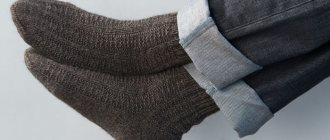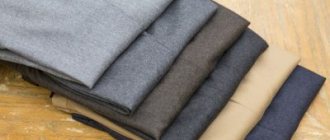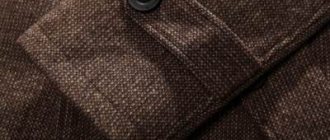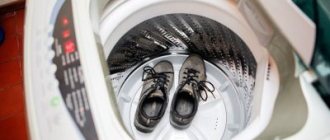Hand washing is not as popular as automatic washing. But in some cases you cannot do without it. You can wash an item by hand effectively and efficiently if you know all the features of this processing process.
Let's take a closer look at how to properly wash clothes and linen by hand, what washing products to use, whether you need to wring things out, and how to dry them.
In what cases is hand washing preferable to machine washing?
When caring for your items, hand washing can be a conscious choice or a necessity. An indication that processing should be done by hand can be found on the product label.
The following categories of things should also not be placed in the machine:
having significant wear and tear;- with contaminants that can damage the washing unit - contaminated with kerosene, gasoline, machine oil and other chemicals;
- leather and leatherette products;
- thin lace items;
- products with complex decor;
- products that have a rigid shape or frame (corsets, hats, etc.).
Manual processing has much fewer restrictions compared to machine processing, as it allows you to vary the intensity of the impact.
Exceptions include products for which dry cleaning only is permitted. For example, coats, hats and other similar products. All other things can be put in order by hand.
Express mode
The duration of the fast method may vary among different brands/models of SMA. This is the fastest option - even in old machines it takes 30-40 minutes. And in more modern modifications it’s even less - 15–20 minutes. Why this option? It is ideal for those who wash something every day, for example:
- diapers, rompers, other baby items;
- socks, napkins, handkerchiefs;
- You can freshen T-shirts and other lightly soiled clothing.
Recommended temperature is 30–40 °C. The spin speed is 800–1200 per minute. The express version is very economical - a minimum of electricity is consumed. The entire cycle from the moment the device starts to the finish takes a maximum of 45 minutes. After light washing, rinse once. If you prefer to change your clothes daily, this option is for you. Items worn more than twice should not be washed in this manner: the machine will not be able to efficiently remove dirt under such delicate conditions.
This version is called differently in different machines - accelerated, super-fast, daily, express. The advantage of the method is the 50% use of powder. But the drum is also loaded at 50%. Otherwise, the detergent will not rinse well out of the fabric fibers.
Preparation for processing
Before putting things into the water, you need to go through the preparatory steps :
- Preparation of the workplace.
- Choosing a detergent.
- Determination of detergent for each specific case.
- Selecting water temperature.
- Sorting things.
At the preparation stage, there are no unimportant details, so each stage must be treated as responsibly as possible.
Workplace organization
When starting to wash by hand, you should take care of the following things:
container (basin);- detergent;
- clothespins;
- trempel;
- hangers with special clips for drying trousers;
- air conditioner;
- latex gloves.
For ease of processing, it is desirable that there are two basins, not one. One is for washing, and the second is for rinsing.
If possible, the workplace should be organized so that you do not have to constantly bend over too much . When washing in an awkward position, you can quickly get tired.
The presence of rubber gloves will reliably protect your hands from prolonged contact with household chemicals and water. If they are not used, cracks and irritation may occur on the skin.
Sorting laundry
As with machine washing, manual processing requires sorting of products. In this case, you should adhere to the following rules:
- Delicate fabrics should not be washed with rough materials.
- Black things should be treated separately from the rest, white things too.
- Shedding products are processed separately from all other products.
Depending on the material, model and degree of contamination, the intensity of the washing process and the need for pre-soaking are determined.
How to choose the right detergent?
The selection of detergent should take into account the color and composition of the fabric. For most products, it is recommended to use detergents in the form of gels rather than powders.
Such drugs have a number of advantages:
- faster dissolution in water when compared with granular formulations;
- uniform distribution in water;
- no sediment;
- good dissolution in water of any temperature (powders are easier to dilute in warm or hot water, and more difficult in cold);
- good rinsing from fabric fibers.
Careful dilution of the powder is a must. If it is violated, damage to the washable material may occur due to the contact of undissolved concentrated granules.
For some types of products, special products are produced designed for washing wool, delicate fabrics, etc.
A good result from washing can be obtained if you choose a product taking into account the color of the material:
- for black;
- for white;
- for colored.
Modern means - oxygen bleaches - can be used to remove stains. They are produced separately for colored and white clothes.
The use of chlorine bleaches is not advisable for a number of reasons:
- Chemical vapors inhaled during washing are harmful to health.
- Can be used with restrictions only on white cotton fabrics.
- Use leads to thinning of the fibers, loss of appearance, rapid wear and tear.
The simplest and most affordable laundry detergent is laundry soap. Its use is not advisable for automatic washing, but is suitable for manual processing. Another plus is that the composition is hypoallergenic, allowing the soap to be used for washing underwear and children’s underwear.
Pre-soaping most items makes washing later much easier.
Water heating temperature
The water temperature is determined based on the permissible temperature for a particular product, and taking into account the fact that it should be tolerable for the hands - no more than +50ºС. If there is no label on the item, then the water temperature is determined by the type of material:
natural linen and cotton can be processed at almost any temperature, but more often around +40ºС;- natural wool and silk – from +30ºС to +40ºС;
- viscose – up to +30ºС;
- synthetics - +40ºС;
- mixed materials – up to +40ºС or +50ºС.
If it is impossible to determine the composition, it is advisable to choose a temperature of +30 - +35ºС for washing.
Washing underwear
It is generally not recommended to machine wash bras and panties. They can be cleaned effectively by hand. To do this, you need to follow simple and clear rules:
- You should not use too hot water, as this can only harm things;
- If the item is made of cotton, you should first soak it in water with the addition of vinegar, and only then use washing powder;
- Lace items must not be twisted or rubbed;
- To wash synthetics, you should not use bleaching agents, otherwise things may simply be damaged;
- Soda is the most “gentle” option for washing underwear. You need to take in the proportion of 1 tbsp. l. at 2.5 l. water, then soak your underwear in this water;
- To keep white things always white, you should use blue.
That's all the intricacies of hand washing. If you stick to it, you will always be able to have clean, washed items in your wardrobe. These recommendations have been time-tested and tried by hundreds of housewives.
How do you like the article?
Instructions
Having a basic knowledge of hand washing, you can begin processing according to the following scheme:
- Determine a place for washing things. It is advisable that it be located in close proximity to a water source.
- You need to pour water at the required temperature into the washing container.
- Dilute the detergent in water according to the instructions on the package.
- Stir the soap solution until foam forms and the detergent is completely dissolved.
- Dip things in water.
- If there are particularly dirty places, they need to be rubbed with soap.
- If things are dirty, they can be left in the basin for up to 20 minutes. In case of significant contamination, cotton items can be soaked for up to 3 hours, and bed linen and kitchen towels for up to 6 hours.
- Rub contaminated areas.
- Squeeze things out a little.
- If you use 2 basins, then transfer things to the second one.
- Drain the dirty water from the first one.
- Take warm water and rinse.
- Take cold water and rinse.
You need to rinse until the water is no longer soapy. If necessary, add an additional rinse.
We wash things as easily and quickly as possible
Many people mistakenly believe that washing by hand is a difficult task. This is wrong. You just need to prepare in advance - take a couple of basins, provide free access to water, and buy the necessary washing powder.
To the point:
- Pour warm water into the first basin and dilute the powder in it. You need to do it correctly: there should be no lumps in the liquid, otherwise things will have streaks. It is very important - the best option for hand washing is liquid laundry detergents;
- Carefully place the items in the water and wait until they are completely wet (10-15 minutes). If you start washing earlier, the fabric simply won’t wash;
- Use three hands to get the dirtiest places on the fabric, or use a not very hard brush;
- We thoroughly “mix” the products in the basin, making sure that they do not get wrapped up or entangled with each other. It is best to do this with gloves - this way the skin on your hands will not suffer;
- We take each product separately, place it in a second basin with cool water, and rinse thoroughly;
- Squeeze out the remaining moisture. If the fabric is very delicate, use a towel, not your hands!
- We send the clothes to dry. Lay out the wool and cashmere on a flat surface, placing a clean cloth underneath.
Using this technique, you can wash absolutely any fabric. An exception is socks, since they are easiest to clean under running water using laundry soap. Now let's talk about washing underwear - it also has its secrets.
Hand-wringing clothes: necessary or not?
After rinsing, items should be wrung out. Twisting must be avoided so as not to deform the product.
During the spin process, you should try to remove as much water as possible . For delicate fabrics, the method of squeezing items through a terry towel is suitable.
For some types of materials, thin and delicate, for example, chiffon, polyester, it is better to exclude spinning and allow the water to simply flow over the bathtub.
Eco
This program is often called "bio-care". Suitable for any fabric with different levels of soiling. There are two stages:
- At first the water is warm - 30–40 degrees. Enzymes are activated.
- Then the temperature rises. The normal process begins.
Its special feature is gentle but thorough removal of old dirt. There are modifications of SMA in which it is necessary to use only powders with enzymes in this mode. Eco is an option that combines softness and intensity. Cycle duration is 120 minutes. There are no contraindications: you can wash synthetics, delicate linen, and children's clothes. This option is especially relevant if the machine does not have separate programs for the above-mentioned products.
How to clean bulk items?
Bulky items, such as parkas and jackets, can be washed using various methods:
- Washing only certain areas of the top layer of fabric.
- Full processing.
Difficulty in washing large items:
- the volume of the thing itself;
- significant weight gain when wet;
- difficulties with spinning and drying.
In cases where a bulky item needs to be washed only from the top, it is better to avoid complete wetness, including the insulation. This type of washing is carried out by hanging the product above the bathtub.
For cleaning use a sponge or soft brush. It is convenient to rinse off soapy water using a shower head, directing it from top to bottom.
If a jacket or other bulky item needs to be washed entirely, you will have to do it right in the bathroom . Hand washing in this case will be very labor-intensive. A wet item should be processed zone by zone, carefully turning it over.
After washing, a product saturated with water requires very careful further processing. Otherwise, the insulation may become deformed, unevenly distributed and disrupt the shape of the entire thing.
To prevent this from happening, you should allow the bulk of the water to drain directly into the bathroom. And only after that proceed to drying.
Drying bulky items should be carried out by turning and repositioning the product , ensuring uniform drying.
Rule 4. Maintain consistency
If you don't know how to wash properly, follow the washing sequence and rules. Instructions:
- We sort things.
- Pour in the required amount of powder.
- Pour some hot water and dissolve the powder.
- Add water and monitor the temperature.
- We soak the clothes. For lightly soiled fabrics, 10–15 minutes is enough, for heavily soiled fabrics – 2–3 hours, bed linen – 10–12 hours (at night).
- We wash: three, press, etc. Particular attention to collars, bottoms of trousers, sleeve cuffs.
- Rinse, changing the water several times, until foamy powder residues no longer appear.
- Add conditioner to the last rinse.
- Wring out the laundry or let it drain.
- We hang it to dry.
Heavy items and woolen sweaters should not be wrung out by hand or hung to prevent them from stretching. Place them on a towel on a horizontal surface.. Photo: dl4.joxi.net
Proper drying
It is recommended to dry any items in a well-ventilated area or outside.
How best to position an item for drying depends on the material, type of clothing, and size:
- blouses, shirts - on trempel;
- bedding - thrown over a rope;
- woolen and acrylic sweaters and pullovers - unfolded, etc.
You can read about all the features of drying hand-washed items here.
How long does it take to rinse in a washing machine?
The time it takes to rinse depends on the options selected. How many rinses are needed is decided either by the machine itself (the manufacturer) or by the user. The laundry needs to be rinsed thoroughly, and you cannot skimp on this. If the user considers it necessary, he sets an additional rinse, which will increase the cycle by 20–30 minutes.
On almost all brands of SMA, rinsing is indicated by the same icon - a basin with a wavy line or straight lines. Rinsing is one of the main steps. On many machines, the “rinse” button is even located separately. When rinsing, the water is automatically drained. The duration depends on the brand and model of SMA. One rinse may take 10–30 minutes.
Cotton
This option is chosen for cotton products. Cotton can withstand high temperatures without compromising its shape or properties. The maximum in the SMA is 95 degrees. Push-ups - from 1200 rpm. The duration of the cycle is 2 hours. There are also programs:
- Cotton 40 degrees - washing time 1.5 hours (90 minutes).
- Cotton 60 degrees - 1 hour 50 minutes. (110 min).
At 95°C you should not wash colored cotton fabrics, only white ones. In such hot water, dyed cotton will fade.
Use of folk remedies
There are eight effective folk remedies that are used to remove stains from fabric.
Ash
Ash left after burning wood is often used to wash clothes. It is carefully wrapped in a gauze bag, after which it is placed in a pan with dirty things. Then the liquid is brought to a boil, soaked for 35-40 minutes and rinsed in warm water.
This method is suitable for all fabrics except delicate ones.
Mustard
Another popular folk remedy used by many housewives. Add 50 grams of mustard to a bowl of hot water. After this, the clothes are soaked in a container with the mustard mixture for about forty minutes. If the stains are absorbed into the fabric, pour mustard onto the contaminated areas and moisten with water.
Bean decoction
Some housewives use bean broth, in which they can quickly wash woolen items. To prepare such a decoction yourself, you need to add 250 grams of beans to a liter of water and boil. Then the mixture is filtered with gauze and poured into a basin with dirty laundry. It is soaked for 40-50 minutes and rinsed with vinegar liquid.
Soap root of the saponaria plant
Knitted fabric can be washed with a soap solution prepared from the root of saponaria. 60 grams of root are added to boiled water, infused and filtered. Then washing is carried out in the filtered liquid.
Potato
Woolen and fadeable fabric materials are washed in potato juice. To prepare it, 2-3 kilograms of peeled potatoes are grated, after which they are squeezed to obtain fresh juice. It is mixed with water heated to 65 degrees and poured into a basin. You can wash all items except whites in the prepared liquid.
Soap nuts
Soap nuts are popular among housewives. They are transferred to small fabric bags and placed in a basin with hot water. After this, the laundry is soaked in the container and washed by hand. Then cold water is poured into the basin and rinsing is carried out.
See also
How to wash tulle in a washing machine, rules and recommendations
Horse chestnut powder
Powder made from chestnut fruits will help fight greasy stains and serious dirt. 100-200 grams of the substance are added to a container filled with 5-6 liters of boiled hot liquid.
This product is universal, as it is used to wash any items.
Salt
To eliminate traces of blood or sweat, use table salt, which is found in every home. When creating a mixture for washing, add 100 grams of salt and vinegar to a two-liter container. Then the clothes are soaked in the liquid for half an hour.











